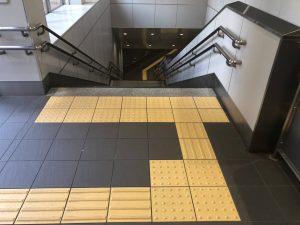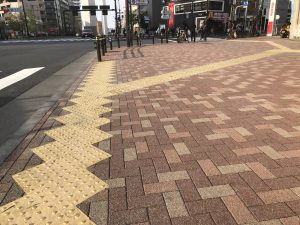 Ask anyone who has been to Japan, and they will always remember the ubiquitous yellow tactile paving blocks. As a tour guide, I am often asked what they are. Designed to assist sight-impaired individuals travel solo, Japan’s tactile paving blocks are typically found everywhere, such as stairs, elevators and railroad station platforms. First created and used in Japan in 1965, today they are utilized in more than 20 other countries around the world. And it all began with one man, whose initial goal was to help a friend.
Ask anyone who has been to Japan, and they will always remember the ubiquitous yellow tactile paving blocks. As a tour guide, I am often asked what they are. Designed to assist sight-impaired individuals travel solo, Japan’s tactile paving blocks are typically found everywhere, such as stairs, elevators and railroad station platforms. First created and used in Japan in 1965, today they are utilized in more than 20 other countries around the world. And it all began with one man, whose initial goal was to help a friend.Origin

History
In 1970, Miyake’s luck changed after a faculty member of the Osaka Prefectural School for the Blind laid a tenji block at the platform of Abikocho Station in Osaka, prompting other stations to follow. In the capital, the Tokyo Metropolitan Government budgeted for 10,000 blocks in Takadanobaba — home to a cluster of facilities for people with visual impairments, including the Japan Federation of the Blind and the Japan Braille Library — making the area the first designated traffic safety model district in the country.
With the initiative showing success, tactile paving was introduced by other municipalities across Japan. The Health, Labour and Welfare Ministry announced that a traffic safety guidance system for people with visual impairments was essential in the delivery of its new model city project and Japan National Railways began installing tactile paving at stations nationwide.
In 1985, tactile paving was mandated for broad use nationwide and, in the 1990s, a Welfare Town Development Ordinance that was enacted in each prefecture — starting with Osaka and Hyogo — brought an uptick in installations.
However, the Tenji blocks were initially far from uniform, causing confusion when visually impaired people traveled outside their local area. In 2001, after a series of experiments and in consultation with experts, a national industrial standard for tactile paving was introduced, thereby making compulsory its standard manufacture (a 5×5 blister pattern for hazard tiles and four long bars for directional tiles).
capital, the Tokyo Metropolitan Government budgeted for 10,000 blocks in Takadanobaba — home to a cluster of facilities for people with visual impairments, including the Japan Federation of the Blind and the Japan Braille Library — making the area the first designated traffic safety model district in the country.
With the initiative showing success, tactile paving was introduced by other municipalities across Japan. The Health, Labour and Welfare Ministry announced that a traffic safety guidance system for people with visual impairments was essential in the delivery of its new model city project and Japan National Railways began installing tactile paving at stations nationwide.
In 1985, tactile paving was mandated for broad use nationwide and, in the 1990s, a Welfare Town Development Ordinance that was enacted in each prefecture — starting with Osaka and Hyogo — brought an uptick in installations.
However, the Tenji blocks were initially far from uniform, causing confusion when visually impaired people traveled outside their local area. In 2001, after a series of experiments and in consultation with experts, a national industrial standard for tactile paving was introduced, thereby making compulsory its standard manufacture (a 5×5 blister pattern for hazard tiles and four long bars for directional tiles).






I’ve been hearing so much about these paving blocks, which eventually led me here in the first place. So I finally see what all the hype has been about.